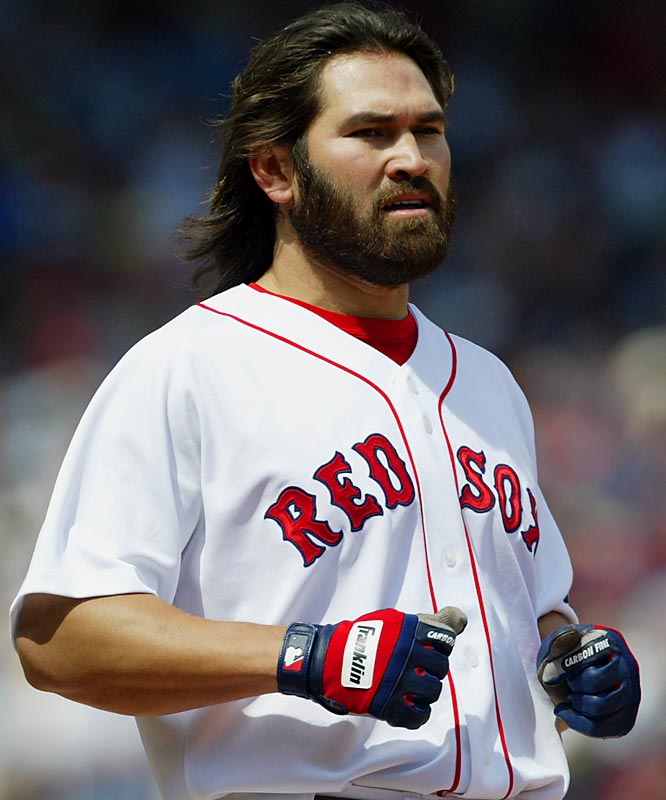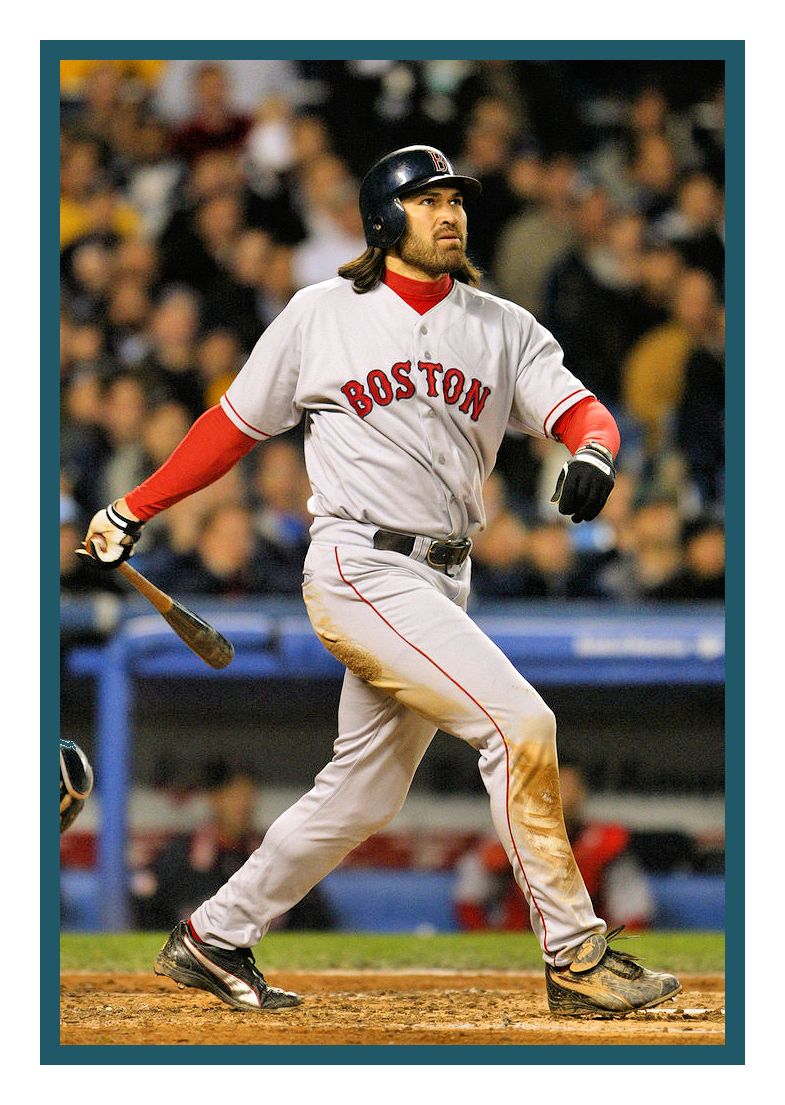 |
|
2002-2005 |
Johnny Damon grew up in
Orlando, Florida, was a
pretty fair football
player and loved the Tampa
Bay Bucs, but first and
foremost, however, he was
a baseball fan. As a
player, he always had
great speed, amazed
himself with his explosive
acceleration, and worked
at his game, always
running to his position in
the baseball field, while
other kids walked.
He made the football team
and eventually developed
into one of the school's
best players in high
school. In the spring of
1989, Johnny won the
varsity starting
centerfield job as a
freshman on the baseball
team. He would go on to be
the first four-year
starter in his school's
history.
He began drawing attention
from big-league clubs as a
sophomore. Ironically, it
was at a 1990 track meet
that the Kansas City
Royals scout first noticed
him. Johnny was a
devastating sprinter in
the 100-and 200-meters,
and after running track,
he would hustlie over to
the baseball team the
moment his events were
done.
His junior year, Johnny
put it all together and
hit .371 with good power.
He opened his senior
baseball campaign amid of
a tidal wave of media
coverage and was Baseball
America’s preseason pick
for the top prep school
player in the nation.
Several colleges were
interested in him as a
sprinter, and he also
toyed with the idea of
playing college football.
When baseball’s draft day
rolled around however,
Johnny was taken by the
Royals in 1992. He signed
with them, joined the
short-season Gulf Coast
Royals and tore it up,
being named the circuit’s
#1 prospect,
He graduated to the
Class-A Midwest League in
1993, where he played for
the Rockford Royals and
claimed honors as the
league's third-best
prospect.
The 1994 season found him
playing high-A ball for
Wilmington of the Carolina
League. At age 20, he
blossomed into a
legitimate four-tool
player, batting .316 with
power, excellent speed and
the best defensive
outfielder, best hitting
prospect and most exciting
player in the league.
The Royals promoted Johnny
one level in 1995,
assigning him to the
Wichita Wranglers of the
Texas League. Two months
into the season, he was
among the league leaders
in five major offensive
categories. His next move
would be to the majors,
not Class-AAA.
In August, his numbers for
Wichita were good enough
for Texas League MVP
honors. Johnny was a
revelation when he came up
to the Royals. He got
three hits, including a
triple, in his first game,
against the Seattle
Mariners. In a contest
against the Texas Rangers,
he challenged catcher
Pudge Rodriguez twice and
won, stealing his first
two bases in the big
leagues.
In 1996, he just held his
own and in 1997, although
his overall stats showed
minor improvement however,
he displayed solid
progress against
left-handed pitchers. Then
in 1998, he saw a big leap
in his performance,
establishing career highs
in most categories,
reaching double-figures in
doubles, triples and
homers while scoring 100
runs for the first time.
He hit 18 home runs which
were more than he had hit
in his first three seasons
combined.
In 1999, with Jermaine
Dye, and Carlos Beltran,
the Royals trio formed the
best young outfield in
majors. They led all of
baseball in hits, doubles,
triples, RBIs and assists.
Johnny topped .300 for the
first time and swiped 36
bases. He had discovered
that the more grounders
and line drives he
produced, the better his
chance of creating havoc
on the basepaths. That
boosted him to elite-level
leadoff status.
After the 2000 season, the
Royals tried to extend
Johnny’s contract but he
decided to play one more
year, and test the free
agent market. So, in
January of 2001, he was
dealt to the Oakland A’s.
He had a decent year, but
nothing like the one that
A’s fans expected. After
stumbling from the gate,
he needed a hot summer
just to bring his average
over .250.
Johnny was then a free
agent, felt terrible about
his subpar season, and in
December 2001, became a
member of the Red Sox.
Fielding an eclectic mix
of support players and
stars, the Sox were
starting to develop a
somewhat
anti-establishment image.
Johnny, who had a classic
square-jawed, clean-cut
look, took a while to come
around to that style, but
he eventually embraced it
and emerged as the Sox
most recognizable player.
Despite the fresh
attitude, the 2002 edition
of the Red Sox still
finished second and missed
the playoffs. Johnny had
an excellent year, leading
the league in triples and
topping the club with 31
steals and 118 runs
scored.
The 2003 Red Sox captured
the Wild Card the
following season and got
contributions across the
board. They pushed the
Yankees to Game #7 in the
ALCS but lost.
After the Yankees had so
thoroughly gotten inside
the heads of the Red Sox,
Johnny laughingly
proclaimed in 2004, that
he and his teammates were
simply going to stop using
their brains. They would
henceforth be known as the
“Idiots”
Their childish behavior
and clubhouse pranks
loosened up the locker
room. Johnny became a
legend when he began doing
naked pull-ups before
games and Terry Francona
saw the benefit of giving
his guys some latitude.
Johnny’s wild look became
the talk of baseball.
When Johnny arrived at
spring training, he
started wearing a T-short
that read “What Curse? We
Have Jesus On Our Side.”
Behind an excellent
offense from top-to-bottom
and Johnny as the
catalyst, with 35 doubles,
20 homers, 123 runs, 19
steals and a .304 average
the Sox would go all the
way.
Thanks to some patient
hitters in the eight-and
nine-holes, he would come
up with tons of men on
base. He slugged .574 in
these situations, and his
94 RBIs were a career
high.
Although the rest of the
Red Sox would come to life
in the ALCS against the
Yankees, Johnny was
slumping badly, with just
three hits in the series.
In Game #7, however, he
would get it together and
strike the knockout blow
with a grandslam homer for
a 6-0 lead in the second
inning. The Sox would
cruise in a 10-3 laugher,
advance to the World
Series and Johnny’s six
RBIs would be a new ALCS
single-game record.
When Johnny would lead off
Game #4 of the World
Series with a home run,
Derek Lowe and the Sox
would have all the support
they needed to finish off
their sweep with a 3-0
win, that broke the "Curse
of the Bambino"
Johnny’s 2005 campaign, however, was less than magical. He cut his arm on Toronto’s new scoreboard in April and ran into a wall in May. The collision left him with a sore shoulder and a splitting headache. The headache went away, but his right arm was in pain the rest of
the year. Johnny was hit by a pitch on the wrist in August and jammed his left shoulder making a catch in September. Despite playing most of the season at less than full strength,
he still made it into 148 games
and batted .316 with 10 homers,
75 RBIs and 18 stolen bases.
After the season, Johnny found himself a free agent in a market devoid of leadoff hitters. Agent Scott Boras set the bar high for bidders, which scared off a lot of teams. Finally, the Yankees came across with a four-year deal worth more than $50 million. Johnny replaced Bernie Williams as
the everyday centerfielder.

|


